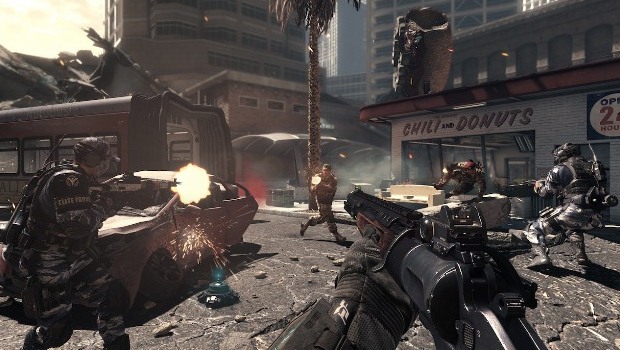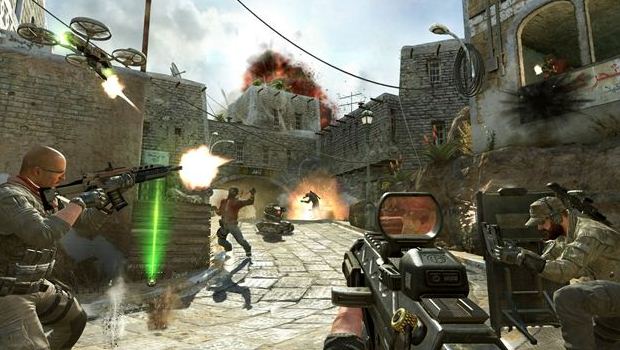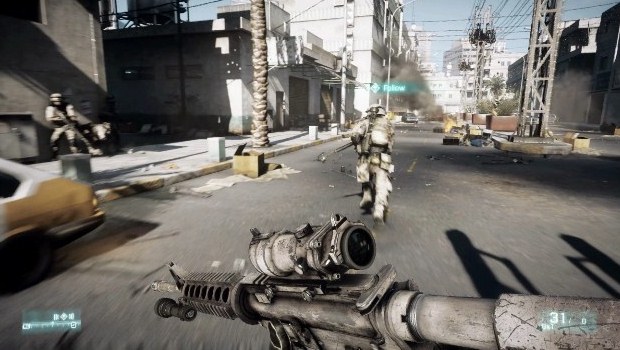On my last entry of On the Frontlines, I discussed the upcoming Battlefield 4 game and gave some initial impressions based on my time with the multiplayer beta. In the comments I was asked (in short) the question: “What is the difference between the two?” That can be a tricky question to answer, especially since it seems everyone favors one over the other. Since I’m up for a challenge, I’m going to accept the mission of answering that question in this installment of On the Frontlines.
The short answer: nearly every significant difference in these two blockbuster shooters can be directly associated with pacing. Despite being in the same genre, they are so drastically different because of their pacing that they are essentially two contrasting games. You simply can’t tell someone “Oh, you like Black Ops 2? Dude, you would love Battlefield 3.” It doesn’t work that way.
Call of Duty sits at the “fast-paced” side of the scale. Maps are usually much smaller, which from the outset develop a much more frantic experience. Even on their larger maps, you can usually find someone in a full game in under a minute if you keep moving. This leaves less downtime, and generally keeps adrenaline up for most of the match. When you are having a great match, that is especially true. This piece is not being written to judge map design, per say, but I do feel Call of Duty is at its best on the smaller maps. The larger maps tend to deviate from the type of experience Call of Duty sells.
On the almost-complete other side of the spectrum is Battlefield. Battlefield is a more methodical shooter. With larger maps, you just have more time to make a plan of attack. It also gives you more breathing time, as you spend at least twice as long running from your spawn point to the objective. Being as the main modes in Battlefield center around an objective, the large maps give you more freedom to attack or defend your objective in more creative ways.
The objective modes in Call of Duty try to simulate this feeling, like other shooters, but DICE has objective-based gameplay pegged down and perfected. The same can be said about Call of Duty’s team deathmatch-style modes, which they have a firm grasp on. Sure, I enjoy Battlefields burst-style modes like TDM and Domination, but they simply don’t compare to Call of Duty.
Digging further into this, overall match time tends to be starkly different. Call of Duty matches tend to last ten minutes or so on average, whereas Battlefield matches (on default settings) last upwards of twenty minutes on average. Of course, game modes play a big part in this statistic.
Unlocks and leveling up your multiplayer character are also polar opposites on the pacing scale. A few years ago, I did an experiment comparing how many unlocks and how many levels I progressed through within a two hour time span with Call of Duty: Modern Warfare 3 and Battlefield 3. At the end of three hours, I was level 7 in Battlefield 3 and level 23 in Modern Warfare 3. As you can tell, there is pretty big void between those two. I spent a few hours with the Battlefield 4 beta and was only level 1 (starting from zero). Call of Duty zips through the levels, throws a ton of unlocks at you, and basically spoils you with widgets and gizmos. Battlefield, on the other hand, rewards you more slowly. The game makes me feel like I worked hard for whatever was just unlocked.
Additionally, Battlefield has two major perks that Call of Duty games simply don’t offer players. The first is vehicles, a staple to the Battlefield franchise since its inception. I’m usually really good at flying games, but could never get a good grasp on flying in Battlefield 3, but land skirmishes featuring tanks are a treat no matter what side you are on. Playing with a good team that is working together, using or disabling vehicles becomes a key component on the field. However, playing on a team that is not working together and playing to their own agenda, tanks, jets and helicopters become a deadly (and annoying) adversary.
In the newer Battlefield games, destruction has played a serious role in how the game plays and feels. Bad Company 2 had small houses that could simply be leveled, rendering what once was a great hideout for a team member to spawn a useless pile of rubble. This plays hand in hand with vehicles, as there is no faster way to level a building and clear out its occupants than blasting it with a tank or helicopter. Destruction, more-so than vehicles really, pushes Battlefield into a territory of its own. Even if Battlefield has a slower, more methodical approach than Call of Duty, there is a layer of dynamic map changes taking place.
Both games, Battlefield and Call of Duty, are, again, on complete opposite sides of the scale. One is not better than the other, they each cater to different types of players. I enjoy both styles, and have a blast playing both games. If you read this far to see who the “winner” was, I’m sorry to inform you that because of their divergent gameplay styles, both Battlefield and Call of Duty play in their own combat zone, sharing only the theme of being military shooters.



